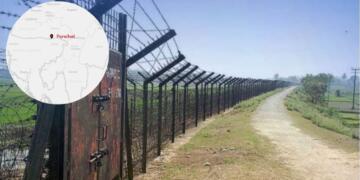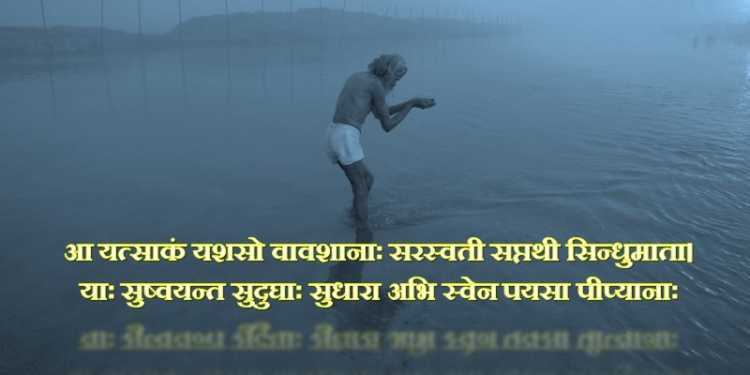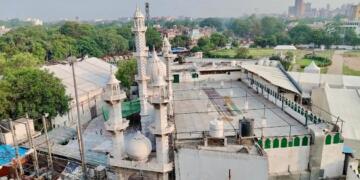||अम्बितमे नदीतमे देवितमे सरस्वती||
“the best of mothers, the best of rivers, the best of Goddesses, River Sarasvati” is how Rig Veda describes river Saraswati. In another part, Rig Veda says
आ यत्साकं यशसो वावशानाः सरस्वती सप्तथी सिन्धुमाता।
याः सुष्वयन्त सुदुघाः सुधारा अभि स्वेन पयसा पीप्यानाः॥
“May the glorious seventh stream Saraswati, mother of Sindhu charged with large volume of water flow vigorously and give milk and water”. All together there are 70+ such references to River Sarasvati in the Rig Veda. In fact, the Nadi stuti sookta mentions an accurate description of Vedic India’s hydrology, counting the rivers that watered it and mentions Sarasvati as flowing between the Yamuna to the East and Sutlej to the West. Mahabharata mentions the origin of River Sarasvati in a place called Plaksh Prashravan and documents that it disappears in the deserts in Vinashana. Further, it specifies that Kurukshetra lay to the south of Saraswati and to the North of Drishadvati river. Other mentions of Sarasvati in the Mahabharata indicate that Sarasvati had become a feeble river by then and was only occupying lakes. From Vedas to Puranas to modern Hinduism, Sarasvati has persisted. Initially, worshipped as a river, Sarasvati became a Goddess in her own right.
What is known is that River Sarasvati has not been around for several millennia. There have been multiple theories on if there was indeed a river Sarasvati and if so, where.
Archaeological excavations in North West India have unearthed sites that could have flourished on the banks of River Sarasvati. Some of these such as Kalibangan, Rakhigarhi etc have given credence to the theory that Indus Valley Civilization was at least an Indus-Sarasvati civilization, if not Sarasvati Valley civilization.
Satellite imagery and other modern techniques continue to indicate that a massive river used to flow in North Western India and discharge its waters into the sea. Or as the Rig Veda says, एकाचेतत्सरस्वती नदीनां शुचिर्यती गिरिभ्य आ समुद्रात् (Pure in her course from the mountains to the oceans).
Some believe that the Ghaghra-Hakra river was the River Sarasvati of yore, as indicated by paleo-channels. Proponents of Aryan Invasion theory believe that the Helmand river of Afghanistan matches Sarasvati’s description. As invading Aryans conquered India, they transferred their memories of a beautiful river that they had crossed in Afghanistan to petty streams in India. Be that as it may, experts are hopelessly divided on what exactly happened to Sarasvati. Some believe that Yamuna and Sutlej deserted Sarasvati due to tectonic shifts (not unknown in North West India) resulting in progressive drying up of the river. Others believe that erosion on its banks caused the river to be subsumed by sands.
And then there are ‘experts’ like Irfan Habib, who believe that Sarasvati is merely a creation of over excited fanatical minds. He sees in the Sarasvati, an attempt by Ultra-nationalits to reclaim Indus Valley Civilization by renaming it as Sarasvati Valley civilization. In fact, he ascribes an interest in River Sarasvati to the RSS and its demagogues. He is unable to make sense of ancient texts and scriptures that define the greatness of Sarasvati. To him, Sarasvati was either another name for Indus or at best a seasonal river by the name Sarsuti that persists. Wearing ideological glasses that personify him and his intellectual brethren, Habib doesn’t want to see or hear of Sarasvati. Romila Thapar, similarly, could find no evidence for River Sarasvati and damned those still holding a belief in Sarasvati by saying “The intention of Hindutva history is to support the vision of its founding fathers — Savarkar and Golwalkar”. To the Thapars and Habibs, India’s past is something that all Indians should be ashamed of and anyone holding a counter view is an agent of the RSS. Intellectual terrorists such as these have reduced every discussion about India’s past to an ideological debate between Communism and Indian native thought. In fact, our eminent intellectuals have been the biggest stumbling blocks in an attempt to discover India’s glorious past.
Michel Danino, the author of The Lost River: On the Trail of the Sarasvati counters the Habibs and Thapars of India by highlighting how they choose to ignore overwhelming evidence and continue to focus on widely discredited theories to prove their ideological maxims. For instance, the first evidence for River Sarasvati came not from Dhoti clad RSS volunteers but from British and European explorers from the colonial era. Of course, these are points that our eminent intellectuals refuse to consider. In their convoluted mind where the Aryan invasion theory reigns supreme and where the Indus Valley Civilization has no civlizational linkage to Vedic and modern India, any acceptance of Sarasvati’s existence would be a big ideological set back. Hence they choose to keep their eyes and continue to squawk the lies that they have been mouthing ever since the mighty Sarasvati disapperead in the desert sands!
As Atharvaveda says
देवा इमं मधूनां संयुतं यवं सरस्वत्या मधि मनावकर्क्रियुः।
इन्द्र आसित सिरपतिः शतक्रतुः किनश आसन मरुतः सुदानवः ।।
(God bestowed the people living on the banks of Saraswati with sweet and juicy barley, where the Maruts become the farmers and Indra, the lord of agriculture.)































